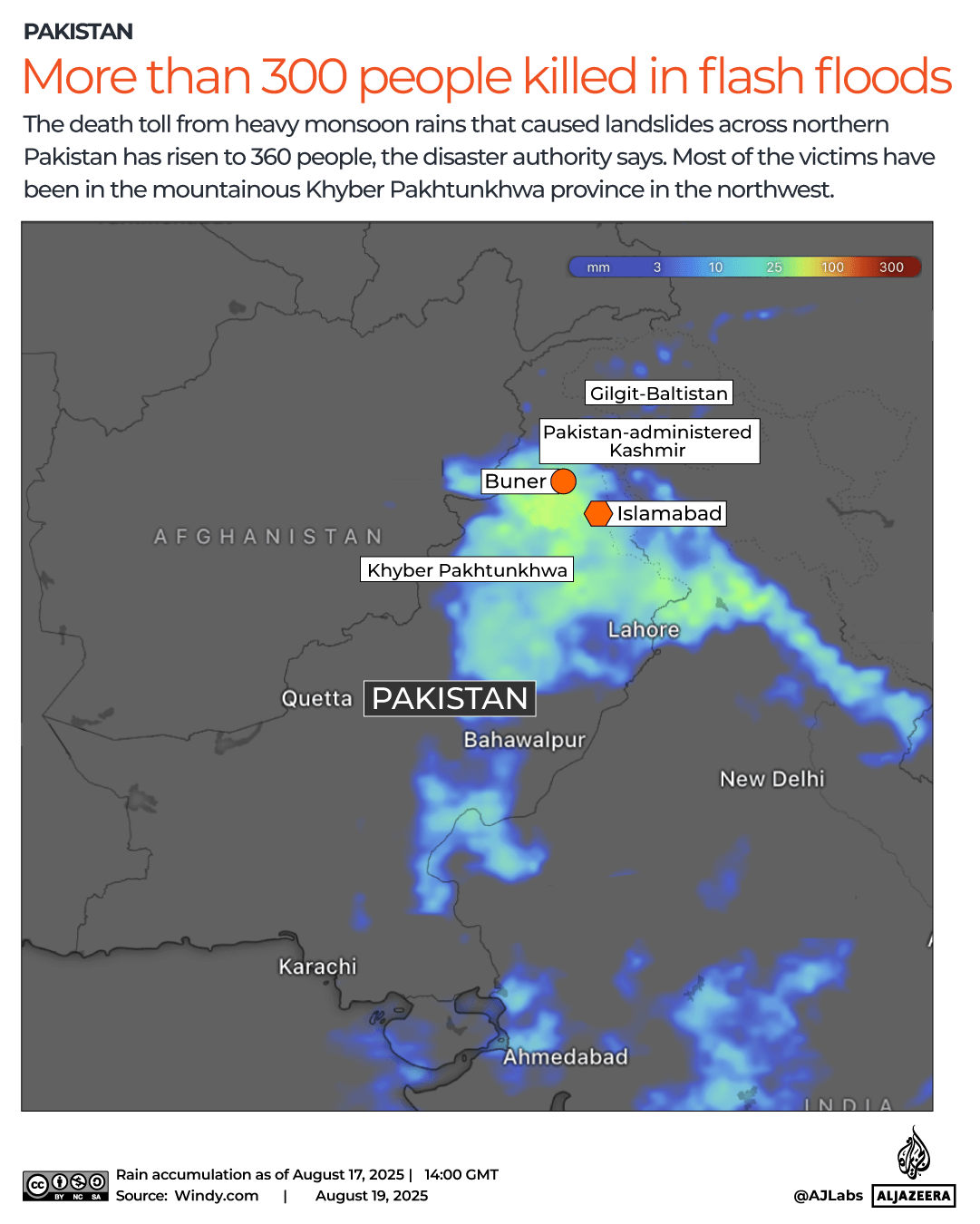At least 360 people have been killed in northern Pakistan and Pakistan-administered Kashmir since Friday, and at least 100 have been missing in the state.
The northwest’s mountainous Khyber Pakhtunkhwa province, where entire villages were wiped away as swollen rivers, mudslides, and collapsing homes left families buried beneath debris, is where the majority of the victims were. Authorities have urged local authorities to remain on the lookout for more deluges and potential landslides.
More than 200 people are killed by floods in Buner.
At least 207 people have died in Buner, a district in Khyber Pakhtunkhwa, over the course of two days as landslides and floods swept through villages and destroyed homes.

Slight slopes that lead to narrow valleys dominate Buner. Landslides and flash floods are a possible result of the district’s loose, erosion-prone soil and deforestation.
After the floods, the mountains and nearby villages, including Pir Baba, were covered in mud and debris.
A cloudburst: what is it?
A cloudburst, a rare event that produces more than 100mm (4 inches) of rain in a small area in an hour, was reported by officials in Buner. More than 150mm (6 inches) of rain fell in Buner on Friday morning in just one hour.
When the weather conditions cause sudden, localized downpours that cause landslides, cloudbursts typically occur in mountainous areas during the monsoon season.
Thunder, lightning, and occasionally hail are frequently accompanied by cloudbursts, which typically occur over a small area of 20 to 30 km (7. 7 to 11.6 km).

A Buner schoolteacher, Aziz Ahmed, claimed the thunderous rumblings from the recent torrential rains made him believe the “end of the world had come.”

Search efforts focused on areas where homes were shattered by massive boulders that smashed into homes like explosions as they were carried away by torrents of water that had fallen from the mountains.
Ahmed cited a house where only one family member was still living, “You can say that those who survived have gone mad.”
Pakistan’s destructive monsoon season
The monsoon season in Pakistan typically lasts from July to September, with August’s peak rainfall being the norm.
More than 650 people have died and nearly 1, 000 have been injured in Pakistan as a result of torrential monsoon rains that have rolled in since late June, according to officials.
At a press conference in Islamabad, National Disaster Management Authority Chairman Lieutenant General Inam Haider Malik claimed that climate change was causing Pakistan to change its weather patterns.
According to Haider, “this year’s monsoon has an intensity of about 50% to 60% more than last year.”
Khyber Pakhtunkhwa, where 425 deaths have been reported, followed by 164 in Punjab, is the province with the worst cases.

About a third of the fatalities were caused by house collapses, while more than half were caused by flash floods.
The extent of destruction to housing and infrastructure is also being highlighted by reports of 719 homes damaged or destroyed in Azad Jammu and Kashmir and 941 in Khyber Pakhtunkhwa. 2, 707 homes have been damaged overall.
Early warning system
Buner officials allegedly failed to warn residents to leave the area. Mosque loudspeakers, a common method in remote areas, did not provide any warning broadcast.
The government claimed that a sudden downpour in Buner occurred before residents could be notified, despite the early warning system being in place.
Pakistan is prone to natural disasters.
Pakistan is one of the most environmentally-vulnerable nations on earth and experiences increasingly severe weather.
The nation experiences frequent heatwaves, heavy rains, glacial lake outburst floods, and sudden cloudbursts that can devastate communities within hours, even though it produces less than 1% of the world’s greenhouse gas emissions.
The monsoon season is frequently marked by flash floods and landslides, particularly in the rugged northwest, where villages are situated on steep slopes and riverbanks.
More than 1,700 people died and estimated $40 billion in damage was caused by Pakistan’s worst monsoon season ever recorded in 2022. According to official data, more than 1,700 people died and at least 20 million were affected by similar floods 12 years earlier.
Source: Aljazeera

Leave a Reply